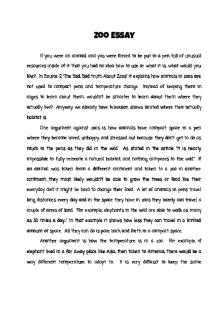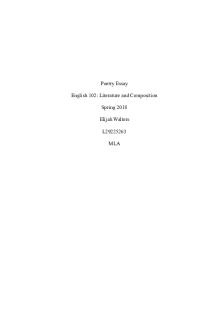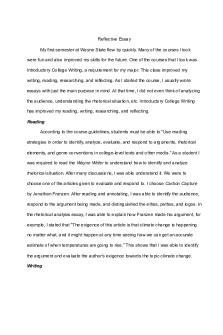Essay \"Nothing Ever Ends\" - Grade B+ PDF

| Title | Essay \"Nothing Ever Ends\" - Grade B+ |
|---|---|
| Author | Isai Rea |
| Course | Reading And Composition |
| Institution | University of California, Berkeley |
| Pages | 5 |
| File Size | 119.8 KB |
| File Type | |
| Total Downloads | 95 |
| Total Views | 131 |
Summary
Essay on Brief and Wondrous Life of Oscar Wao ...
Description
Rea 1 Isai Rea Adrian Acu English R1A: Work and Play April 16March 21, 2016 Nothing Ever Ends In the perilous canefields of the Dominican Republic, Oscar de Leon’s body lays there, murdered, a victim of the notorious fukú, a curse of some sort. Fukú is a central motif in Diaz’s novel The Brief and Wondrous Life of Oscar Wao where the victims of “fukú,” live a miserable life and could only be countered by “zafa” a counterspell to fukú. Two characters associated with the fukú, and zafa are The Man a Face Without a Face and a golden mongoose; eache; each appearance of either of these symbolic characters is loaded withexemplifies meaning; they often appear at a time when a monumental event is about to occurring is about to happen. The presence of the Man Without a Face is associated with an event involving fukú, while the golden mongoose appears after the Man Without a Face countering the fukú in the form of zafa. The mongoose acts as a sort of guardian angel to Beli and later to Oscar; his presence relates to “zafa” the counterspell to the curse, while the Man Without a Face is a portent to fukú, indicating that the curse is active and following events, will be cursed. The novel is surrounded by a general curse or doom of some kind and is referred to as the notorious – fukú. Oscar de Leon’s unfortunate bad luck with girls and Belicia Cabral’s atrocious heartbreaks are all associated with the fukú, and the family has come to accept that their dismal lives are an outcome the curse bestowed upon the family. A recurring character in the story
Rea 2 novel is – the Man Without a Face, – an intriguing character that is the harbinger of fukú, and his presence indicates that the curse is active and that subsequent events will be cursed. The Man Without a Face first appears as Beli is being driven back into town as she is awhile crossing a pubelito,“[Beli] would have sworn that a man sitting in a rocking chair in front of her had no face” (135).
The reader’s first encounter with the faceless man is paradoxical; before the he
appears to Beli, she sees a goat being skinned.witness the skinning of a goat. However, the goat’s skin was still attached to its face “like a funeral mask” (135). An identity is built by one’s man anatomically needs to have a face, his face serves as his identityface, but in this case, we have a faceless man with no identity man with an empty façade, while an animal has a face, a sort of funeral mask which represents perfection and is associated with an identity. The Man Without a Face is an actual victim of violent oppression.
During a regime like Trujillo's, plenty
of people disappear . aAnd nobody ever finds out about the disappearances nor what happenswhat happened to them. People suspect, b. But ultimately they do notn't know. It is's possible that the Man Without a Face is meant to remind us of this fact: that tons of Trujillo's victims have remained nameless (faceless), and they haunt this novel. The Man Without a Face is an omen of bad luck every time the reader encounters him; it is a prelude to catastrophe, the living embodiment of – fukú. Oscar de Leon’s unfortunate bad luck with girls and Belicia Cabral’s atrocious heartbreaks are all associated with the fukú, and the family has come to accept that their dismal lives are the outcome of a curse bestowed upon the family. For Beli, her first encounter with the faceless man correlates with her pregnancy, “Two days later… she was pregnant” (136). Beli’s pregnancy is part of the fukú, which haunts her family as she will later on almost be beaten toforeshadows her controversial near death experience during her death because of her
Rea 3 pregnancy. The second time the Beli encountered the faceless an is before she is nearly killed-, severely beaten in the canfield by Elvis One and Elvis Two. Beli sees one more cop sitting in the car and “when he turn[s] toward her she [sees] that he [does not] have a face” (141). After this, Beli is nearly beaten to death and left to die in the canfield, her baby dead and the fukú did its job as aforementioned back in her first encounter in the cab ride back to Bani. After Beli’s traumatizing experience she has nightmares, “of the cane, of the Faceless One (161).” The Man Without a Face is an omen of misery and fukú, in Beli’s life. Belicia Cabral is not the only person to encounter the faceless man. Oscar also has unpleasant encounters with the man with no face. Oscar sees the faceless man for the first time when he is being driven to the canefield for a beat-down after being caught kissing Ybon. On the drive, he sees, "a lone man sitting in his rocking chair ... for a moment, Oscar could have sworn the dude had no face” (298). Like Beli's first sighting of the faceless man, he is sitting in a rocking chair in front of a shabby house as Oscar drives by. Later, during his beating, "there were moments Oscar was sure that he was being beaten by three men, not two, that the faceless man from in front of the colmado was joining them” (299). The second time Oscar is driven to the canefields, the party drives past a bus stop and, "for a second, Oscar imagine[s] he [sees] his whole family getting on the bus ... and who is the cobrador but the Man Without a Face” (320321). The Man Without a Face is a physical representation of the De Leon’s family’s fukú,, he appears to both mother and son, in near death experiences; Beli’s beating because of her illegitimate child and Oscar’s beating because of the nature of his kiss with Ybon. The fukú,, the master of evil, responsible for the austere life that the De Leon family experiences can only be prevented and countered by a single word – Zafa. Zafa becomes your best friend trying to repel the fukú, and for the De Leon family, their Zafa comes in the form of a
Rea 4 godly golden mongoose. The first appearance of the mongoose is in the canefield after Beli is nearly killed by Trujillo’s men. As Beli is “flitting in and out of life,” a mongoose with “golden lion eyes” appears at her side and tells her “ ‘You have to rise now, or you’ll never have the son or daughter’ ” (149). The mongoose is a supernatural being given with the ability of it to communicate with Beli and lead her out of the canefields. The timing of the mongoose’s appearance coincides,ing with the extreme prayer gathering held by La Inca. This critical timing indicates that the mongoose is not a bad omen, (like the man with no face) but rather a protective spirit. Also, this promising spirit is indicative of his in telling Beli’s survival by informing her about her future children (Lola and Oscar) is crucial to her survival. “Each time [Beli] thought she would fall she concentrated on the faces of her promised future- her promised children- and from that obtained the strength she needed” (150). At a time when all hope seemed lost, the mongoose appeared to provide hope and guidehelp Beli’s survivale. The Mongooses’ next appearance has a similar purpose. Our heroic mongoose appears once more when Oscar is on the New Brunswick train bridge contemplating suicide. Oscar recalls the mongoose as a “very placid, very beautiful” creature with “Gold-limned eyes that reached through you, not so much in judgment or reproach but for something far scarier” (190). Again, we see the mongoose has a bright physical appearance, emphasizing the with gold also emphasized. Despite that Oscar’s choice to still chooses to jump off the bridge, his survival is nothing short of a miracle. Therefore, the Mongoose is a figure that protects those who encounter it. In Dominican Republic’s culture, the mongoose could be a symbol of Zafa or good luck. The “golden” physical appearance of the mongoose that is compared to a lion characterizes it as a symbol of something powerful and protective forces. Considering the circumstances that both Beli and Oscar faced when they encounteredwhile they encountered the mongoose, it is clear that
Rea 5 without some divine intervention or stroke of good luck, and they both would have ended up dead. However, towards the end of the novel, there is an anomaly in the overall pattern observed through the novel which consisted of fukú, with the appearance of the faceless man and zafa with the golden mongoose. Interestingly, as Oscar drove by a bus stop, he imagines “his whole family getting on… who is driving the bus but the Mongoose, and who is the cobrador but the Man Without a Face” (320-321). It is the first time when both the fukú and zafa are present at the same time. Oscar’s death followed immediately in the canefields no more fukú, to haunt Oscar, no more zafa to protect him—only death. However, the cycle continues, because the fukú and zafa will find another victim to claim/aid. Fukú, and zafa are essential to the plot of The Brief and Wondrous Life of Oscar Wao, as they are in essence what drives the novel and are drastically effect most characters in it. Fukú and zafa are portrayed via two characters: the Man Without a Face (fukú,) and the golden mongoose (zafa). Oscar and Beli are the characters that interact with them and are proof of the curse and its counterspell. Despite the death of Oscar, the curse does not simply end; fukú and zafa are timeless and blind affecting generation after generation. The final narration of Yunior the story to the allusion of Watchmen the zafa and fukú, will never end – “In the end? Nothing ends. Nothing ever does”....
Similar Free PDFs

Rogerian Essay - Grade: B
- 2 Pages

Zoo Essay - Grade: B+
- 2 Pages

Causation Essay - Grade: B
- 4 Pages

Final Essay - Grade: B+
- 12 Pages

Propaganda Essay - Grade: b
- 4 Pages

Poetry Essay - Grade: B
- 5 Pages

Galileo Essay - Grade: B+
- 6 Pages

Fiction Essay - Grade: B
- 7 Pages

EPQ Essay - Grade: B+
- 10 Pages

Law essay - Grade: B
- 9 Pages

Persuasive Essay - Grade: B
- 3 Pages

Evicted Essay - Grade: B+
- 3 Pages

Charities essay - Grade: B+
- 13 Pages

Reflective Essay - Grade: B
- 4 Pages

Analysis essay - Grade: B+
- 3 Pages
Popular Institutions
- Tinajero National High School - Annex
- Politeknik Caltex Riau
- Yokohama City University
- SGT University
- University of Al-Qadisiyah
- Divine Word College of Vigan
- Techniek College Rotterdam
- Universidade de Santiago
- Universiti Teknologi MARA Cawangan Johor Kampus Pasir Gudang
- Poltekkes Kemenkes Yogyakarta
- Baguio City National High School
- Colegio san marcos
- preparatoria uno
- Centro de Bachillerato Tecnológico Industrial y de Servicios No. 107
- Dalian Maritime University
- Quang Trung Secondary School
- Colegio Tecnológico en Informática
- Corporación Regional de Educación Superior
- Grupo CEDVA
- Dar Al Uloom University
- Centro de Estudios Preuniversitarios de la Universidad Nacional de Ingeniería
- 上智大学
- Aakash International School, Nuna Majara
- San Felipe Neri Catholic School
- Kang Chiao International School - New Taipei City
- Misamis Occidental National High School
- Institución Educativa Escuela Normal Juan Ladrilleros
- Kolehiyo ng Pantukan
- Batanes State College
- Instituto Continental
- Sekolah Menengah Kejuruan Kesehatan Kaltara (Tarakan)
- Colegio de La Inmaculada Concepcion - Cebu
